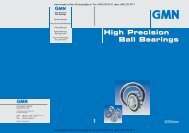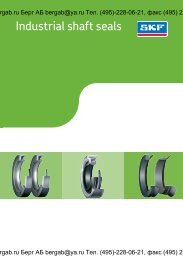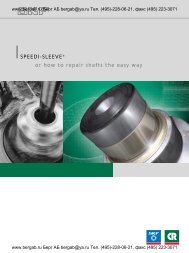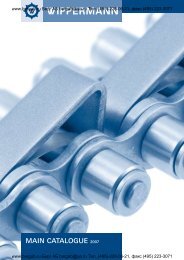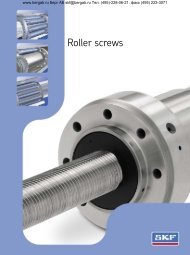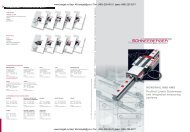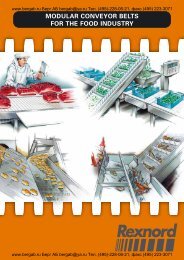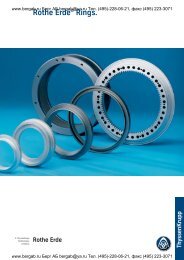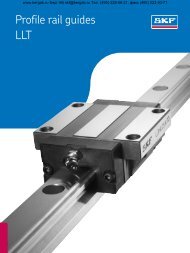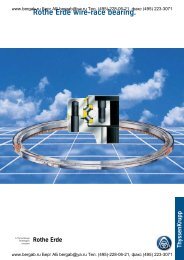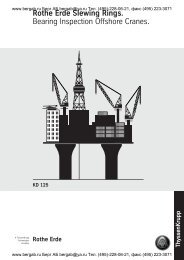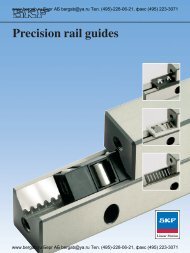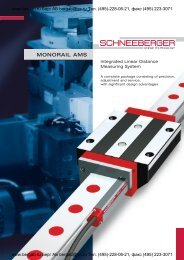Industrial shaft seals
Industrial shaft seals
Industrial shaft seals
Create successful ePaper yourself
Turn your PDF publications into a flip-book with our unique Google optimized e-Paper software.
gab.ru<br />
Radial<br />
Берг<br />
<strong>shaft</strong>АБ <strong>seals</strong><br />
bergab@ya.ru Тел. (495)-228-06-21, факс (495) 22<br />
Housing bore requirements, large diameter <strong>seals</strong> (LDS)<br />
General<br />
The following requirements are designed to<br />
guarantee the requisite interference fit for the<br />
seal, the necessary static sealing and proper<br />
installation.<br />
Housing bores for <strong>seals</strong> with steel shells<br />
To ensure that the seal can be installed<br />
without damaging it, the housing bore should<br />
have a 5 to 10° lead-in chamfer. The transition<br />
should be free from burrs and the transition<br />
between the seal seating and the shoulder<br />
should have a radius not exceeding 0,8 mm.<br />
The depth of the housing bore (t 2 ) should be<br />
at least 0,3 mm greater than the nominal seal<br />
width b. The cylindrical section (t 1 ) of the bore<br />
should have a width of at least 0,85 b, (fig 48).<br />
Recesses in the housing shoulder, which<br />
must be considered at the design stage,<br />
considerably facilitate removal of a seal from<br />
the housing bore, (fig 49).<br />
Housing bores and end covers for HS and<br />
HSF <strong>seals</strong> of elastomers<br />
To ease installation and prevent damage to the<br />
<strong>seals</strong> during mounting, the housing bore should<br />
have a lead-in chamfer of 5 to 10°, fig 49. The<br />
transition should be free of burrs and the<br />
transition between seal seating and housing<br />
shoulder should have a radius which does not<br />
exceed R = 0,8 mm.<br />
In contrast to the other radial <strong>shaft</strong> <strong>seals</strong> the<br />
non-split and split HS and HSF <strong>seals</strong> must be<br />
axially clamped in the housing bore. This is<br />
usually achieved by an end cover screwed to<br />
the housing wall. The real width of the seal is<br />
between 0,4 and 0,8 mm larger than the<br />
nominal width of the seal housing groove (t 2 ).<br />
The axial clamping so achieved gives the HS<br />
and HSF seal the requisite firm fit in the<br />
housing and the correct form for efficient<br />
sealing.<br />
The actual seal outside diameter is<br />
approximately 0,5 % to 2 % larger than the seal<br />
housing bore.<br />
The end cover should be sufficiently thickwalled,<br />
depending on diameter and the axial<br />
clamping distance, wall thicknesses of between<br />
6 and 12 mm have been found appropriate.<br />
The cover should be screwed to the machined<br />
housing wall following the recommendations<br />
given in fig 49. To provide additional protection<br />
to the sealing lip against coarse contaminants<br />
the inside diameter of the cover should be<br />
some 6 to 8 mm larger than the <strong>shaft</strong> diameter<br />
d 1 . There are no limits regarding the outside<br />
diameter of the cover. To ease mounting and<br />
any subsequent seal replacement, it is<br />
recommended that the cover be made in two<br />
halves and an even number of screws used.<br />
The end face should be made plane parallel<br />
and the machined housing wall should be at<br />
right angles to the housing bore.<br />
gab.ru 82 Берг АБ bergab@ya.ru Тел. (495)-228-06-21, факс (495) 22



